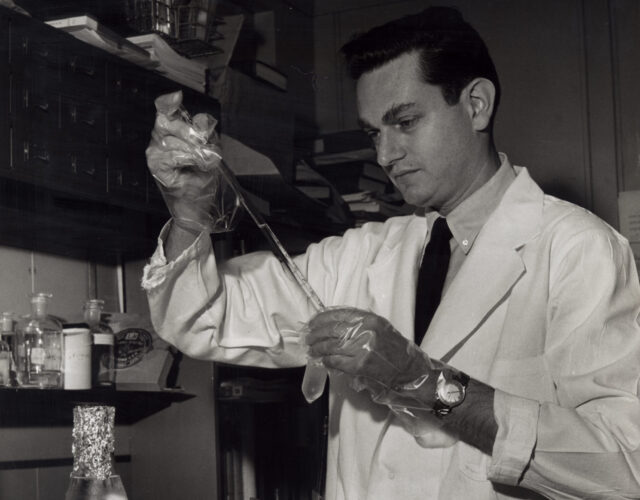Marshall Nirenberg just wanted to have fun at work. As he told me in 2009, “By fun, I mean I wanted to explore an important problem, and I wanted to discover things.”
Five decades earlier Nirenberg, winner of the 1968 Nobel Prize in Physiology or Medicine, faced a dilemma: what should he study? He’d been offered a position as a research biochemist at the National Institutes of Health and after some thought decided to investigate the relationship between deoxyribonucleic acid (DNA), ribonucleic acid (RNA), and protein production.
“The best biochemists in the world were working on the mechanism of protein synthesis, and the best molecular biologists in the world were working on how genes are regulated in E. coli,” he said.
The brash young Nirenberg had no experience in either field. His PhD focused on the mechanism of sugar uptake in tumor cells. But in 1959, only two years after getting his PhD and with no training as a molecular biologist, he proposed to probe the genetic code.
Nirenberg’s first question proved crucial: does messenger RNA exist—that is, could RNA mediate the synthesis of proteins?
Interest in the genetic code was boiling over in those years, after James Watson and Francis Crick electrified the world by revealing their double-helix model of DNA structure in their 1953 Nature article. The two recognized that the double-strand structure might allow replication. But how could DNA, made up of only four different nucleotides, determine the composition of the many proteins in living organisms? This question fueled the race to discover the genetic code, through which information coded in DNA is translated into proteins.
Nirenberg’s initial goal was to determine the template for protein synthesis. With no formal training, no staff, and no experience in the field, he entered a race in which the professional stakes were high.
Nirenberg teamed up with Heinrich Matthaei, a postdoctoral fellow from Germany. In a series of experiments the cell contents of E. coli were added to test tubes. “I asked Heinrich to make 20 different solutions of amino acids, each one with 19 ‘cold’ and one radioactive amino acid and to test the poly U,” Nirenberg said. Any reaction mediated by RNA involving a “hot” amino acid would produce a “hot” protein.
Success came at three in the morning on May 27, 1961, when Matthaei added synthetic RNA (UUU or poly U) made of only one of the four bases—uracil (U)—to each of the 20 test tubes and found unusual activity in one of the tubes containing the “hot” amino acid phenylalanine. The uracil had given the phenylalanine instructions. Nirenberg, then at the University of California, Berkeley, rushed back to Bethesda. The two had shown that messenger RNA transcribes genetic information from DNA, directing the assembly of amino acids into complex proteins. A key to breaking the genetic code—molecular biology’s Rosetta Stone—had been discovered.
In August 1961 Nirenberg traveled to Moscow to present his results at the International Congress of Biochemistry. As an unknown, only 35 people attended his talk. But in one of those serendipitous events that change everything, Nirenberg had met Watson the day before and told him about his results. Though skeptical, Watson consulted a colleague, who reported that Nirenberg’s findings were real. Watson relayed this to Crick, who arranged for Nirenberg to present his paper again. This time he received a standing ovation. “For the next five years I became like a scientific rock star,” he said.
But even rock stars have to produce or risk falling out of the spotlight. Shortly after Nirenberg’s Moscow success, researchers in Severo Ochoa’s laboratory at New York University showed that other polynucleotides, or combinations of the four bases, direct the incorporation of amino acids into proteins. Ochoa’s laboratory was now far ahead in the race to crack the genetic code. Nirenberg wondered how he could compete against Ochoa’s group of 20 scientists.
The day after he learned of Ochoa’s success, Nirenberg ran into a colleague, Robert Martin, who promised to “lend a hand” and stopped his own work for months to synthesize polynucleotides for Nirenberg.
What Nirenberg called “a rather strange round-the-clock collaboration” began. Maxine Singer, another NIH colleague, provided enzymes; Martin worked from midafternoon to 1:00 a.m.; Matthaei worked overnight testing for protein synthesis (when the radioactivity counters were more likely to be available). Nirenberg worked the day shift analyzing the data generated by the 24-hour cycle. By the end of 1961 they had tentatively arrived at a large number of code words.
Nirenberg built on the original poly-U experiment in which he and Matthaei had cracked the first “word” (UUU for phenylalanine) of the genetic code. By 1966 Nirenberg and his team had deciphered the 64 RNA three-letter code words (codons) for directing all 20 amino acids.
Two years later Nirenberg won the Nobel Prize, which he shared with Har Gobind Khorana, who mastered the synthesis of nucleic acids, and Robert Holley, who discovered the chemical structure of transfer RNA.
As a Nobel laureate Nirenberg received many university job offers. He turned them all down. “I figured that if I went to a university I would use a third of my time to write grants,” he said. “I thought I could use that time more productively by doing experiments.” Nirenberg died on January 15, 2010, after a lifetime of just the kind of fun he liked.




